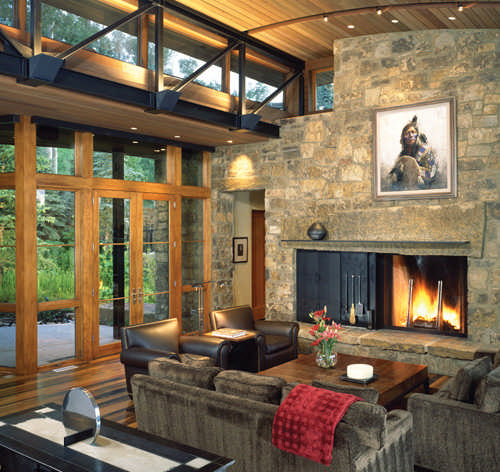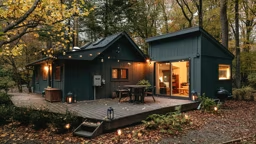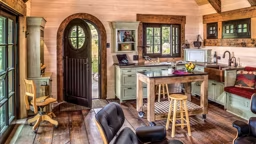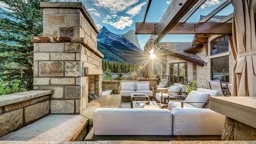It’s a proven fact that engaging your senses in surroundings derived from nature brings relaxation and rejuvenation. No wonder people are designing their cabins, cottages and lake- homes with rustic components.
Being drawn to rustic design is only natural – it makes you feel like you’re one with nature. Rustic design runs the gamut from traditional – where going out on a limb can be literal, to contemporary – with clean flowing lines. From one-room cabins to 10,000-square-foot ski chalets, rustically designed structures come in all shapes and sizes. What they all share, though, is a connection with the landscape. Through natural building materials, like wood and stone, the Great Outdoors is embodied and brought inside.
Rustic Roots
Rustic has its roots in the Adirondack Great Camps of upstate New York. These Gilded Age retreats of science and industry’s movers and shakers were no more “camps” than their Newport cousins were “cottages.” Set on remote lakeshores (some are still accessible only by boat or dirt road), these retreats had year-round staff and modern conveniences like gaslights and running water.
Use of native woods and stone – such as argillite for lodges in Montana, cedar for cabins in Texas and granite for California and New York cabins – provides a natural sense of place for the getaway. “We’re creating more seamless thresholds between indoor and outdoor living spaces, which is just as important as the Great Room,” says Yaw.
At elevations of 9,000 feet, the mountain environment becomes a design issue. Snow and ultraviolet rays deteriorate wood at a rapid rate. So Yaw steers clients toward stone or corrugated metal at foundation level, reserving cedar for more sheltered spots. “Sometimes we won’t even use wood.” With rain and snow sometimes arriving horizontally with the wind, overhangs are a common feature to protect both exterior and interior. Additionally, Yaw recommends a non-combustible metal or zinc roof, which can prevent wildfire from destroying a cabin.
At elevations of 9,000 feet, the mountain environment becomes a design issue. Snow and ultraviolet rays deteriorate wood at a rapid rate. So Yaw steers clients toward stone or corrugated metal at foundation level, reserving cedar for more sheltered spots. “Sometimes we won’t even use wood.” With rain and snow sometimes arriving horizontally with the wind, overhangs are a common feature to protect both exterior and interior. Additionally, Yaw recommends a non-combustible metal or zinc roof, which can prevent wildfire from destroying a cabin.
Well-known Sagamore Lodge, built in 1897 and now a conference center, had a covered open-air bowling alley installed in 1914, which is still in use today. Covered walkways linked the main lodge with sleeping cabins and the dining hall. Still, these compounds tread lightly on the land. Instead of excavated foundations, point footings let camps “roll with the hills,” says architectural historian Wesley Haynes. Following natural contours maximized views and cross-ventilation.
The Great Camps blended into the forest with their bark-on log construction. Brown was the predominant color accented with hunter green and red. Shingled roofs with deep overhangs, stonework, twig mosaic embellishments and wrap around porches defined the Adirondack style. “The porch was as much a central part of the living environment as the interior,” adds Haynes.
The Great Camps blended into the forest with their bark-on log construction. Brown was the predominant color accented with hunter green and red. Shingled roofs with deep overhangs, stonework, twig mosaic embellishments and wrap around porches defined the Adirondack style. “The porch was as much a central part of the living environment as the interior,” adds Haynes.
Here, dynastic families like the Vanderbilts, Rockefellers and Morgans enjoyed idyllic summers boating and fishing, hiking and hunting. “Rustic became equated with freedom,” says Haynes. “You didn’t have to dress for dinner."
Defining the New Rustic
Taking inspiration from the Great Camps – but with clean, flowing, contemporary lines – this Horton, Mich., great room’s rustic architectural design elements include exposed beams, large windows and the use of natural materials such as stone and wood.
The room’s rustic décor touches include a trophy moose, antler chandelier and a log mantel. The look is softened with animal print upholstery, antique-style furnishings and lush, bright plants. The home was designed by Riverbend Timber Framing.
Defining the New Rustic
Taking inspiration from the Great Camps – but with clean, flowing, contemporary lines – this Horton, Mich., great room’s rustic architectural design elements include exposed beams, large windows and the use of natural materials such as stone and wood.
The room’s rustic décor touches include a trophy moose, antler chandelier and a log mantel. The look is softened with animal print upholstery, antique-style furnishings and lush, bright plants. The home was designed by Riverbend Timber Framing.
Rustic Branches Out
Adirondack style was very influential progressing to hunting lodges in Maine, Appalachian mountain cabins and west to the Great Lakes and Rockies. The National Park Service even adopted the style for lodges across the country.
The look varied depending upon local weather and land conditions, available materials, heritage and tradition. In the South, for example, rustic cabins sport square-cut logs with wide chinking. Locust railings, laurel balusters and gold Tennessee fieldstones also convey Southern comfort, according to rustic design expert and author Ann O’Leary. Squared-log Texas Hill Country cabins reflect the German heritage of that particular area.
Scandinavian log-building techniques helped shape North Woods style, says architect Katherine Hillbrand of SALA Architects in Stillwater, Minn. Round, bark-on logs with chinking, big corner posts and large, flat window and door trim are a throwback to the Midwest’s Swedish settlers. Low-slung lakeside cabins hug the ground; limestone foundations protect wood walls from snow and splash back. “Modern Midwest cabins tend to be clean cut with large windows and wood (not knotty pine) walls and ceilings,” says Hillbrand.
Adirondack style was very influential progressing to hunting lodges in Maine, Appalachian mountain cabins and west to the Great Lakes and Rockies. The National Park Service even adopted the style for lodges across the country.
The look varied depending upon local weather and land conditions, available materials, heritage and tradition. In the South, for example, rustic cabins sport square-cut logs with wide chinking. Locust railings, laurel balusters and gold Tennessee fieldstones also convey Southern comfort, according to rustic design expert and author Ann O’Leary. Squared-log Texas Hill Country cabins reflect the German heritage of that particular area.
Scandinavian log-building techniques helped shape North Woods style, says architect Katherine Hillbrand of SALA Architects in Stillwater, Minn. Round, bark-on logs with chinking, big corner posts and large, flat window and door trim are a throwback to the Midwest’s Swedish settlers. Low-slung lakeside cabins hug the ground; limestone foundations protect wood walls from snow and splash back. “Modern Midwest cabins tend to be clean cut with large windows and wood (not knotty pine) walls and ceilings,” says Hillbrand.
Western dude ranches adopted the Great Camp compound plan with their main lodges, bunkhouses, stables and barns. Old West-style log cabins evoke the frontier spirit with rough sawn boards, sandstone, two-over-two windows and rusted tin roofs.
New West architecture is a contemporary remake of rustic – mixing material palettes such as steel and concrete with timber and stone. “A lot of our clients don’t want the vernacular historical approach,” says Larry Yaw of CCY Architects in Basalt, Colo. “Their tastes are contemporary. They have different aesthetic preferences.” While new energy sources – passive solar, photovoltaic cells and wind power – shape abstract building forms, regional materials tie the cabin to the site.
New West architecture is a contemporary remake of rustic – mixing material palettes such as steel and concrete with timber and stone. “A lot of our clients don’t want the vernacular historical approach,” says Larry Yaw of CCY Architects in Basalt, Colo. “Their tastes are contemporary. They have different aesthetic preferences.” While new energy sources – passive solar, photovoltaic cells and wind power – shape abstract building forms, regional materials tie the cabin to the site.
Not only has contemporary rustic design taken advantage of more modern materials, it has lightened up since pioneer times. Expanses of thermal-pane glass allow in more daylight, turning interiors bright and airy. Today’s rustic cabins are well heated, insulated and sound-proofed. Still, there are lessons to learn from the past. “People today want the spectacular view, so they get up on a promontory,” says Haynes. “But if you’re trying to capture the feeling of a 19th century cabin, put it in a place that makes sense for natural comfort – shade in summer, good solar gain in winter, protection from winds.”
Whether you are building new or wanting to give your place a rustic touch, the best building blocks are the ones native to your neck of the woods. For rustic-chic interior design ideas you can use for your getaway, click here.
Fran Sigurdsson enjoys the rustic life at her home in the Adirondacks.
RESOURCE: Ann O’Leary, designer, author of “Rustic Revisited” and owner of Evergreen House Interiors in Lake Placid, N.Y.
Whether you are building new or wanting to give your place a rustic touch, the best building blocks are the ones native to your neck of the woods. For rustic-chic interior design ideas you can use for your getaway, click here.
Fran Sigurdsson enjoys the rustic life at her home in the Adirondacks.
RESOURCE: Ann O’Leary, designer, author of “Rustic Revisited” and owner of Evergreen House Interiors in Lake Placid, N.Y.



 Roger Wade, courtesy Riverbend Timber Framing
Roger Wade, courtesy Riverbend Timber Framing 












